Advertisements
Chapters
2: Linear Equations in One Variable
▶ 3: Understanding Quadrilaterals
4: Data Handling
5: Squares and Square Roots
6: Cubes and Cube Roots
7: Comparing Quantities
8: Algebraic Expressions and Identities
9: Mensuration
10: Exponents and Powers
11: Direct and Inverse Proportions
12: Factorisation
13: Introduction to Graphs
![NCERT solutions for Mathematics [English] Class 8 chapter 3 - Understanding Quadrilaterals NCERT solutions for Mathematics [English] Class 8 chapter 3 - Understanding Quadrilaterals - Shaalaa.com](/images/mathematics-english-class-8_6:a152220a99ba47cf8d1b775ab26b8834.jpg)
Advertisements
Solutions for Chapter 3: Understanding Quadrilaterals
Below listed, you can find solutions for Chapter 3 of CBSE NCERT for Mathematics [English] Class 8.
NCERT solutions for Mathematics [English] Class 8 3 Understanding Quadrilaterals EXERCISE 3.1 [Page 22]
Given here are some figures:
 |
 |
 |
 |
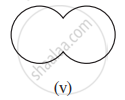 |
 |
 |
 |
Classify each of them on the basis of the following:
- Simple curve
- Simple closed curve
- Polygon
- Convex polygon
- Concave polygon
What is a regular polygon?
State the name of a regular polygon of 3 sides.
State the name of a regular polygon of 4 sides.
State the name of a regular polygon of 6 sides.
NCERT solutions for Mathematics [English] Class 8 3 Understanding Quadrilaterals EXERCISE 3.2 [Page 24]
Find x in the following figure:
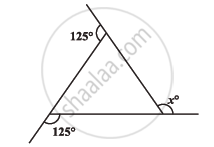
Find x in the following figures.
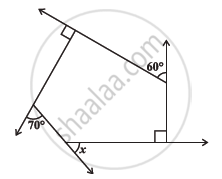
Find the measure of each exterior angle of a regular polygon of 9 sides.
Find the measure of each exterior angle of a regular polygon of 15 sides
How many sides does a regular polygon have if the measure of an exterior angle is 24°?
How many sides does a regular polygon have if each of its interior angles is 165°?
Is it possible to have a regular polygon with measure of each exterior angle as 22°?
Can it be an interior angle of a regular polygon? Why?
What is the minimum interior angle possible for a regular polygon? Why?
What is the maximum exterior angle possible for a regular polygon?
NCERT solutions for Mathematics [English] Class 8 3 Understanding Quadrilaterals EXERCISE 3.3 [Pages 30 - 32]
Given a parallelogram ABCD. Complete each statement along with the definition or property used.

- AD = ______
- ∠DCB = ______
- OC = ______
- m∠DAB + m∠CDA = ______
Consider the given parallelogram. Find the values of the unknowns x, y, z.

Consider the given parallelogram. Find the values of the unknowns x, y, z.
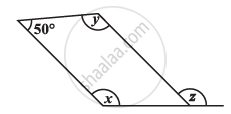
Consider the given parallelograms. Find the values of the unknowns x, y, z.
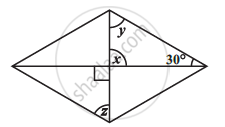
Consider the given parallelograms. Find the values of the unknowns x, y, z.
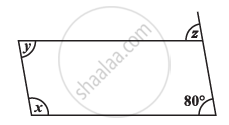
Consider the given parallelograms. Find the values of the unknowns x, y, z.
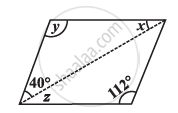
Can a quadrilateral ABCD be a parallelogram if ∠D + ∠B = 180°?
Can a quadrilateral ABCD be a parallelogram if AB = DC = 8 cm, AD = 4 cm and BC = 4.4 cm?
Can a quadrilateral ABCD be a parallelogram if ∠A = 70° and ∠C = 65°?
Draw a rough figure of a quadrilateral that is not a parallelogram but has exactly two opposite angles of equal measure.
The measures of two adjacent angles of a parallelogram are in the ratio 3 : 2. Find the measure of each of the angles of the parallelogram.
Two adjacent angles of a parallelogram have equal measure. Find the measure of each of the angles of the parallelogram.
The adjacent figure HOPE is a parallelogram. Find the angle measures x, y and z. State the properties you use to find them.

The following figure GUNS is a parallelogram. Find x and y. (Lengths are in cm)

The following figure RUNS is parallelogram. Find x and y. (Lengths are in cm)

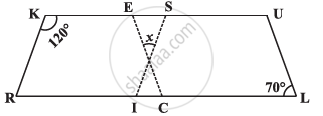
In the above figure both RISK and CLUE are parallelograms. Find the value of x.
Explain how this figure is a trapezium. Which of its two sides are parallel?
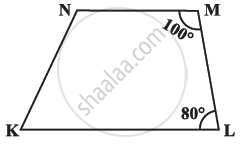
Find m∠C in the following figure if `bar(AB) || bar(DC)`
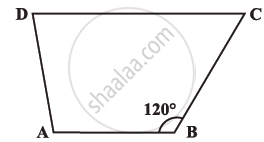
Find the measure of ∠P and ∠S, if `bar(SP) || bar(RQ)` in the following figure. (If you find m∠R, is there more than one method to find m∠P?).
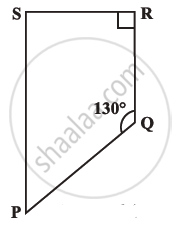
NCERT solutions for Mathematics [English] Class 8 3 Understanding Quadrilaterals EXERCISE 3.4 [Page 35]
State whether True or False.
All rectangles are squares
True
False
All rhombuses are parallelograms.
True
False
All squares are rhombuses and also rectangles.
True
False
All squares are not parallelograms.
True
False
All kites are rhombuses.
True
False
All rhombuses are kites.
True
False
All parallelograms are trapeziums.
True
False
All squares are trapeziums.
True
False
Identify all the quadrilateral that have Four sides of equal length
Identify all the quadrilaterals that have four right angles
Explain how a square is a quadrilateral
Explain how a square is a parallelogram
Explain how a square is a rhombus.
Explain how a square is a rectangle
Name the quadrilaterals whose diagonals bisect each other
Name the quadrilaterals whose diagonals are perpendicular bisectors of each other
Name the quadrilaterals whose diagonals are equal
Explain why a rectangle is a convex quadrilateral.
ABC is a right-angled triangle and O is the mid point of the side opposite to the right angle. Explain why O is equidistant from A, B and C. (The dotted lines are drawn additionally to help you)
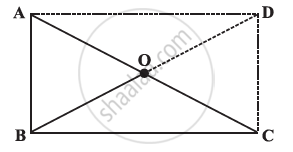
Solutions for 3: Understanding Quadrilaterals
![NCERT solutions for Mathematics [English] Class 8 chapter 3 - Understanding Quadrilaterals NCERT solutions for Mathematics [English] Class 8 chapter 3 - Understanding Quadrilaterals - Shaalaa.com](/images/mathematics-english-class-8_6:a152220a99ba47cf8d1b775ab26b8834.jpg)
NCERT solutions for Mathematics [English] Class 8 chapter 3 - Understanding Quadrilaterals
Shaalaa.com has the CBSE Mathematics Mathematics [English] Class 8 CBSE solutions in a manner that help students grasp basic concepts better and faster. The detailed, step-by-step solutions will help you understand the concepts better and clarify any confusion. NCERT solutions for Mathematics Mathematics [English] Class 8 CBSE 3 (Understanding Quadrilaterals) include all questions with answers and detailed explanations. This will clear students' doubts about questions and improve their application skills while preparing for board exams.
Further, we at Shaalaa.com provide such solutions so students can prepare for written exams. NCERT textbook solutions can be a core help for self-study and provide excellent self-help guidance for students.
Concepts covered in Mathematics [English] Class 8 chapter 3 Understanding Quadrilaterals are Properties of Trapezium, Properties of Kite, Classification of Polygons, Properties of a Parallelogram, Concept of Curves, Interior Angles of a Polygon, Exterior Angles of a Polygon and Its Property, Concept of Polygons, Concept of Quadrilaterals, Property: The diagonals of a rhombus are perpendicular bisectors of one another., Properties of Rhombus, Property: The Opposite Sides of a Parallelogram Are of Equal Length., Property: The Opposite Angles of a Parallelogram Are of Equal Measure., Property: The adjacent angles in a parallelogram are supplementary., Property: The diagonals of a parallelogram bisect each other. (at the point of their intersection), Property: The Diagonals of a Rectangle Are of Equal Length., Properties of Rectangle, Properties of a Square, Property: The diagonals of a square are perpendicular bisectors of each other., Properties of a Quadrilateral, Different Types of Curves - Closed Curve, Open Curve, Simple Curve., Properties of Trapezium, Properties of Kite, Classification of Polygons, Properties of a Parallelogram, Concept of Curves, Interior Angles of a Polygon, Exterior Angles of a Polygon and Its Property, Concept of Polygons, Concept of Quadrilaterals, Property: The diagonals of a rhombus are perpendicular bisectors of one another., Properties of Rhombus, Property: The Opposite Sides of a Parallelogram Are of Equal Length., Property: The Opposite Angles of a Parallelogram Are of Equal Measure., Property: The adjacent angles in a parallelogram are supplementary., Property: The diagonals of a parallelogram bisect each other. (at the point of their intersection), Property: The Diagonals of a Rectangle Are of Equal Length., Properties of Rectangle, Properties of a Square, Property: The diagonals of a square are perpendicular bisectors of each other., Properties of a Quadrilateral, Different Types of Curves - Closed Curve, Open Curve, Simple Curve..
Using NCERT Mathematics [English] Class 8 solutions Understanding Quadrilaterals exercise by students is an easy way to prepare for the exams, as they involve solutions arranged chapter-wise and also page-wise. The questions involved in NCERT Solutions are essential questions that can be asked in the final exam. Maximum CBSE Mathematics [English] Class 8 students prefer NCERT Textbook Solutions to score more in exams.
Get the free view of Chapter 3, Understanding Quadrilaterals Mathematics [English] Class 8 additional questions for Mathematics Mathematics [English] Class 8 CBSE, and you can use Shaalaa.com to keep it handy for your exam preparation.
